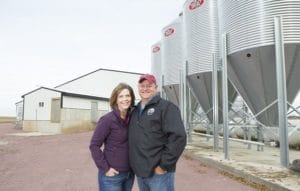
Then suddenly, we started to see pictures of rotting vegetables in the fields and milk being dumped from tankers and we questioned how this could be when we have food banks pleading for donations and grocery shelves empty. As mentioned in an earlier blog, when 50% of the “farm to plate” food system shuts down with 100% of people still to feed, it’s not easy or even possible to change a processing and distribution system at a moment’s notice without warning — a task that has been described as similar to “turning around a battleship.” In time, we can — and are starting to — change production lines and distribution centers and loosen some “red tape” along the way to move food from food service size to retail size, but only so long as we have the human power to manage the work. And when we don’t, a perfect storm blows through the food chain leaving meat animals and farmers “stranded on an island” with consumers feeling the tidal waves.
The Farm Reality
To understand the situation today, especially on the hog production side, one needs to roll back the calendar nine or 10 months when hog producers, like South Dakota’s Steve & Charlotte Rommereim (RDN, LD) or Jim Petrik of Petrik Farms, were planning production based on factors like an increased global demand for pork due to African Swine Fever, an improved tariff situation and an overall positive economic outlook, all of which led to increased sow breeding and an anticipated improved financial forecast. Fast forward to today’s situation. Both farms experienced one of the first large pork plant closures in Sioux Falls. Now others in Iowa, Minnesota and Nebraska face the same reality. Truckloads of pigs are ready for bacon, ribs and chops but with major processing plants closed due to employee safety and the spread of COVID-19, farmers face tough choices.

Pork producers are not in this situation alone as dairy farmers, beef ranchers and poultry growers share similar woes, but beef and poultry have a little more flexibly.2 Cattle can be fed longer without negative consequences. Poultry production has a shorter life cycle and production can be slowed down by not hatching chicks. Regardless of the animal, the situation is the same. When the processing stops or slows down, the tidal waves are felt throughout the system creating ripples of discontent, distrust and discord.
The Processing Reality
Closure of animal processing plants in more than a dozen states in recent weeks — spanning beef, pork, poultry and fish products — has populated headlines across the country as COVID-19 infects the well-being of employees. With plant closures has come more scrutiny about worker safety, proper processing operations and, most recently, national orders to keep plants open.

Steve & Charlotte Rommereim
on their South Dakota farm
Regardless of our personal views of what we deem is the “right decision,” the U.S. Department of Agriculture (USDA) is using its authority under the president’s new executive order to require meat processors to provide documentation of their implementation of the proper steps to curb coronavirus outbreaks. This includes “mitigation plans for review” by a USDA-led team along with representatives from the U.S. Department of Labor and Centers for Disease Control. This “team” along with state and local authorities are to review the documentation “swiftly to resume and/or ensure continuity of operations at these critical facilities.” The good news is this move also gives USDA some authority to procure personal protective equipment and COVID-19 tests for processing plant employees.3
The Personal Dilemma
When a catastrophic situation like COVID-19 suddenly interrupts our daily lives and most importantly, our “life line” of food, we all have an opinion and judgment can set in. As long as our bacon is on our plate and the grocery shelves are filled with meat, we don’t think about the complexity of the system. But when the food chain breaks, we begin asking “who’s right and who’s wrong”? For some, this may be viewed as an opportunity to capitalize on the benefits of reducing or eliminating animal protein from our diets. Others may question the perceived monopoly of “big ag” processing plants. And some may view this as the time to “eat only local.”
Regardless of our personal views, the reality is that as consumers we are the least affected. According to Jayson Lusk, an ag economist at Purdue University, “It will be impossible for consumers not to notice effects on meat prices or availability in the coming weeks due to plant closures and slow-downs from COVID-19 but options will still exist.” In fact, processing of pork and beef products are 40% less now than they were in April 2019, according to Lusk.4 The good news is that our meat supply is still safe!5 Here are some facts:
- As Jim Petrik, in his Facebook Live post on April 8 noted, “The health of our pigs is safe.” The same animal care procedures are in place as were pre-COVID-19.
- The processing plants are clean. The plants closed to provide additional deep cleaning and sanitation when employees were diagnosed with COVID-19. As noted by USDA, new employee safety guidelines are in place for all processing plants and will have to be followed for the foreseeable future to remain open.
- There is no evidence of food or meat being associated with the transmission of the coronavirus at this time. It’s important to recognize that unlike foodborne gastrointestinal (GI, or stomach-related), viruses that often make people ill through contaminated food, coronavirus is a virus that causes respiratory (breathing-related) illness.
For farmers and ranchers, the inconvenience is not as incidental. Higher prices in the grocery stores do not equate to better prices for farmers regardless of the product. In fact, it’s just the opposite. For example, it is projected that pork producers will lose nearly $37 per hog, or almost $5 billion collectively for the rest of the year6 and for some, it could be more. This situation could also lead to the loss of multi-generational farming operations.
Learning Forward
Regardless of our backgrounds or business, we all have been affected by this global pandemic and we won’t return to “normal.” Every day brings new challenges and opportunities as those working in the food supply chain know well. Learnings will not be forgotten and the food system will evolve to address our future world. We, too as consumers, have learned. Our expectation of “always having what we want” when it comes to food comes at a price…from the worker in the field, to the farm owner, to the processing plant, and beyond. Even in a “perfect storm,” we still have food on the table. Our farmers and food suppliers are resilient. And for that I am thankful.
Special thanks to: Danita Rodibaugh, past president of the National Pork Board (NPB), former chair of the U.S. Meat Export Federation (USMEF) and partner in Rodibaugh & Sons in Rensselaer, Indiana; and Charlotte Rommereim, RDN, LN, LD with Farm to Fork Communications and partner in Rommereim Farms in Alcester, South Dakota, for their farm insights, which contributed to this article.
References:
1. Smith Edge, Marianne. The Balancing Act-Nutrition and Sustainability. Nutrition Today, vol 55 (2), 2020.
2. Poynter’s News University
3. Agri-Pulse Daybreak, [email protected], April 30, 2020
4. Jayson Lusk, http://jaysonlusk.com/
5. Charlotte Rommereim, “Pork Food Safety During COVID-19,” Farm to Fork Communications.
6. Quote from Dermot Hayes, Iowa State University economist, and Steve Meyer, a pork industry economist with agricultural risk management firm Kerns & Associates.
Resources:
Indiana Pork Producers Association, COVID-19 Resources for Indiana Livestock Producers
